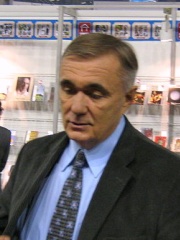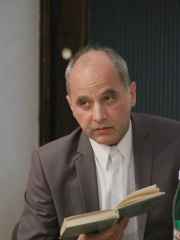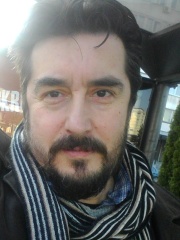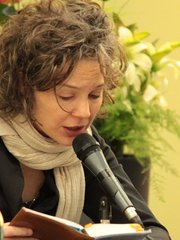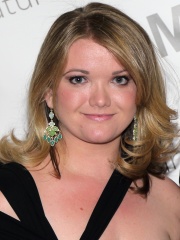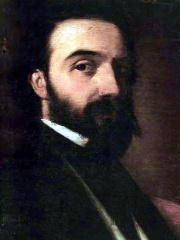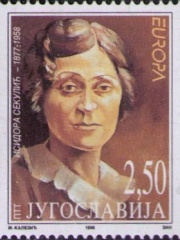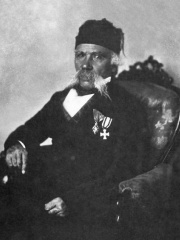
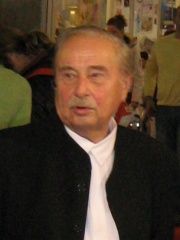
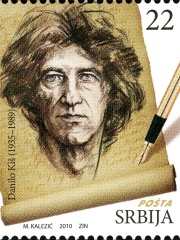
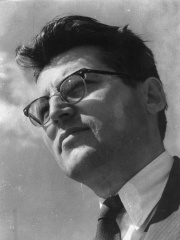
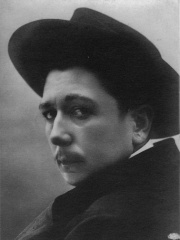
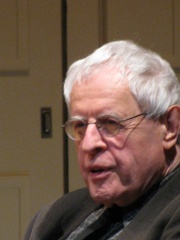
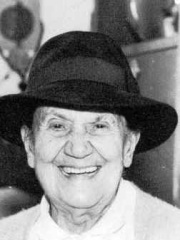
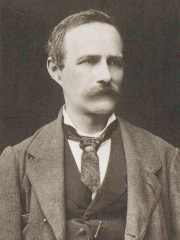
The Most Famous
WRITERS from Serbia
This page contains a list of the greatest Serbian Writers. The pantheon dataset contains 7,302 Writers, 30 of which were born in Serbia. This makes Serbia the birth place of the 40th most number of Writers behind Iraq, and Azerbaijan.
Top 10
The following people are considered by Pantheon to be the top 10 most legendary Serbian Writers of all time. This list of famous Serbian Writers is sorted by HPI (Historical Popularity Index), a metric that aggregates information on a biography's online popularity. Visit the rankings page to view the entire list of Serbian Writers.

1. Vuk Karadžić (1787 - 1864)
With an HPI of 73.39, Vuk Karadžić is the most famous Serbian Writer. His biography has been translated into 53 different languages on wikipedia.
Vuk Stefanović Karadžić (Serbian Cyrillic: Вук Стефановић Караџић, pronounced [ʋûːk stefǎːnoʋitɕ kâradʒitɕ]; 6 November 1787 (26 October OS) – 7 February 1864) was a Serbian philologist, anthropologist and linguist. He was one of the most important reformers of the modern Serbian language. Vuk Karadžić was a versatile scholar and the founder of several Serbian academic disciplines, with a significant contribution to historiography. For his collection and preservation of Serbian folktales, Encyclopædia Britannica labelled Karadžić "the father of Serbian folk-literature scholarship." He was also the author of the first Serbian dictionary in the new reformed language. In addition, he translated the New Testament into the reformed form of the Serbian spelling and language. He was well known abroad and familiar to Jacob Grimm, Johann Wolfgang von Goethe and historian Leopold von Ranke. Karadžić was the primary source for Ranke's Die serbische Revolution ("The Serbian Revolution"), written in 1829.

2. Milorad Pavić (1929 - 2009)
With an HPI of 69.60, Milorad Pavić is the 2nd most famous Serbian Writer. His biography has been translated into 44 different languages.
Milorad Pavić (Serbian Cyrillic: Милорад Павић, pronounced [mîloraːd pǎːʋitɕ]; 15 October 1929 – 30 November 2009) was a Serbian writer, university professor, translator, literary historian and academic. He published a number of poems, short stories and novels during his lifetime, the most famous of which was the Dictionary of the Khazars (1984). Upon its release, it was hailed as "the first novel of the 21st century." Pavić's works have been translated into more than thirty languages. He was vastly popular in Europe and in South America, and was deemed "one of the most intriguing writers from the beginning of the 21st century." He won numerous prizes in Serbia and in the former Yugoslavia, and was mentioned several times as a potential candidate for the Nobel Prize in Literature.

3. Danilo Kiš (1935 - 1989)
With an HPI of 68.92, Danilo Kiš is the 3rd most famous Serbian Writer. His biography has been translated into 41 different languages.
Danilo Kiš (Serbian Cyrillic: Данило Киш; born Dániel Kiss; 22 February 1935 – 15 October 1989) was a Yugoslav and Serbian novelist, short story writer, essayist and translator. His best known works include Hourglass, A Tomb for Boris Davidovich and The Encyclopedia of the Dead.

4. Dobrica Ćosić (1921 - 2014)
With an HPI of 68.78, Dobrica Ćosić is the 4th most famous Serbian Writer. His biography has been translated into 36 different languages.
Dobrica Ćosić (Serbian Cyrillic: Добрица Ћосић, pronounced [dǒbritsa tɕôːsitɕ]; 29 December 1921 – 18 May 2014) was a Yugoslav and Serbian writer, politician and political theorist. Ćosić was twice awarded the prestigious NIN award for literature and Medal of Pushkin for his writing. His books have been translated into 30 languages. He was the first President of the Federal Republic of Yugoslavia with his tenure lasting from 1992 to 1993. Admirers sometimes refer to him as the Father of the Nation due to his influence on modern Serbian politics and the national revival movement in the late 1980s while his opponents use that term in an ironic manner.
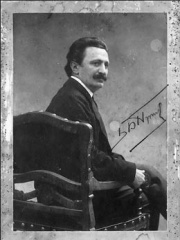
5. Branislav Nušić (1864 - 1938)
With an HPI of 68.23, Branislav Nušić is the 5th most famous Serbian Writer. His biography has been translated into 42 different languages.
Branislav Nušić (Serbian Cyrillic: Бранислав Нушић, pronounced [brǎnislav̞ nûʃit͡ɕ]; 20 October [O.S. 8 October] 1864 – 19 January 1938) was a Serbian playwright, satirist, essayist, novelist and founder of modern rhetoric in Serbia. He also worked as a journalist and a civil servant.

6. Radoje Domanović (1873 - 1908)
With an HPI of 67.73, Radoje Domanović is the 6th most famous Serbian Writer. His biography has been translated into 64 different languages.
Radoje Domanović (Serbian Cyrillic: Радоје Домановић; February 16, 1873 – August 17, 1908) was a Serbian journalist, writer and teacher, most famous for his satirical short stories. His adult years were a constant fight against tuberculosis. This circumstance of his life, and the affection which he inspired in all who knew him, created an aura of romanticism and sentimentality which stand in contrast to his literary accomplishments as a satirist and a powerful critic of the contemporary Serbian society.

7. Charles Simic (1938 - 2023)
With an HPI of 67.22, Charles Simic is the 7th most famous Serbian Writer. His biography has been translated into 27 different languages.
Dušan Simić (Serbian Cyrillic: Душан Симић, pronounced [dǔʃan sǐːmitɕ]; May 9, 1938 – January 9, 2023), known as Charles Simic, was a Serbian American poet and poetry co-editor of The Paris Review. He received the Pulitzer Prize for Poetry in 1990 for The World Doesn't End and was a finalist of the Pulitzer Prize in 1986 for Selected Poems, 1963–1983 and in 1987 for Unending Blues. He was appointed the fifteenth United States Poet Laureate in 2007.

8. Desanka Maksimović (1898 - 1993)
With an HPI of 63.18, Desanka Maksimović is the 8th most famous Serbian Writer. Her biography has been translated into 27 different languages.
Desanka Maksimović (Serbian Cyrillic: Десанка Максимовић; 16 May 1898 – 11 February 1993) was a Serbian poet, writer and translator. Her first works were published in the literary journal Misao in 1920, while she was studying at the University of Belgrade. Within a few years, her poems appeared in the Serbian Literary Herald, Belgrade's most influential literary publication. In 1925, Maksimović earned a French Government scholarship for a year's study at the University of Paris. Upon her return, she was appointed a professor at Belgrade's elite First High School for Girls, a position she would hold continuously until World War II. In 1933, Maksimović married Sergej Slastikov, a Russian émigré writer. After being dismissed from her post at the high school by the Germans in 1941, she was reduced to a state of poverty and forced to work odd jobs to survive the three-and-a-half year occupation. She was only permitted to publish children's literature during this period, but secretly compiled a collection of patriotic poems, which were not published until after the war. Among these was Krvava bajka (A Bloody Tale), about the Wehrmacht's killing of schoolchildren in the Kragujevac massacre. It was recited extensively in post-war commemorative ceremonies and became one of the best known Serbian-language poems. To mark her 60th birthday, Maksimović was named the recipient of a string of honours and awards in 1958. In 1964, she published one of her most acclaimed works, a volume of reflective poetry entitled Tražim pomilovanje (I Seek Clemency). The work's veiled critique of the Tito government made it especially popular. The following year, she became a full-fledged member of the Serbian Academy of Sciences and Arts. Following her husband's death in 1970, Maksimović's poetry increasingly began to revolve around the subject of human mortality. Maksimović travelled extensively in the 1970s and 1980s, and some of her visits abroad inspired several of her works. She became involved in efforts to combat government censorship in the early 1980s and was active until her death in 1993. Maksimović was the first female Serbian poet to gain widespread acceptance within Yugoslav literary circles and among the general public. One literary scholar notes that she served as an example for other Serbian women wishing to take up the craft. Maksimović's reputation, which was such that most of her contemporaries referred to her simply by her first name, has led one author to describe her as "the most beloved Serbian poet of the twentieth century".

9. Jovan Jovanović Zmaj (1833 - 1904)
With an HPI of 62.94, Jovan Jovanović Zmaj is the 9th most famous Serbian Writer. His biography has been translated into 23 different languages.
Jovan Jovanović Zmaj (Serbian Cyrillic: Јован Јовановић Змаj, pronounced [jɔ̌v̞an jɔv̞ǎːnɔv̞it͡ɕ zmâj]; 24 November 1833 – 1 June 1904) was a Serbian poet, translator and physician. Jovanović worked as a physician; he wrote in many poetry genres, including love, lyric, patriotic, political, and youth, but he remains best known for his children's poetry. His nursery rhymes have entered the Serbian national consciousness and people sing them to their children without knowing who wrote them. Jovanović also translated the works of some of the great poets, such as Russians Lermontov and Pushkin, Germans Goethe and Heine, and the American Longfellow. Jovanović's nickname Zmaj or Змај (dragon) derives from the 3 May 1848 assembly.
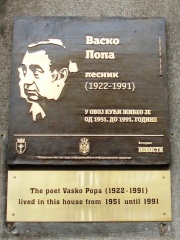
10. Vasko Popa (1922 - 1991)
With an HPI of 62.22, Vasko Popa is the 10th most famous Serbian Writer. His biography has been translated into 23 different languages.
Vasile "Vasko" Popa (Serbian Cyrillic: Васко Попа; 29 June 1922 – 5 January 1991) was a Yugoslav and Serbian poet of ethnic-Romanian heritage. He is regarded as one of 20th-century Yugoslavia's and Serbia's most important poets, and his work has been widely translated.
People
Pantheon has 30 people classified as Serbian writers born between 1726 and 1985. Of these 30, 7 (23.33%) of them are still alive today. The most famous living Serbian writers include Dušan Kovačević, Prvoslav Vujcic, and Dejan Ajdačić. The most famous deceased Serbian writers include Vuk Karadžić, Milorad Pavić, and Danilo Kiš. As of April 2024, 2 new Serbian writers have been added to Pantheon including Miodrag Kojadinović, and Melinda Nadj Abonji.
Living Serbian Writers
Go to all RankingsDušan Kovačević
1948 - Present
HPI: 57.59
Prvoslav Vujcic
1960 - Present
HPI: 55.42
Dejan Ajdačić
1959 - Present
HPI: 51.91
Zoran Stefanović
1969 - Present
HPI: 48.08
Miodrag Kojadinović
1961 - Present
HPI: 45.59
Melinda Nadj Abonji
1968 - Present
HPI: 42.59
Téa Obreht
1985 - Present
HPI: 30.15
Deceased Serbian Writers
Go to all RankingsVuk Karadžić
1787 - 1864
HPI: 73.39
Milorad Pavić
1929 - 2009
HPI: 69.60
Danilo Kiš
1935 - 1989
HPI: 68.92
Dobrica Ćosić
1921 - 2014
HPI: 68.78
Branislav Nušić
1864 - 1938
HPI: 68.23
Radoje Domanović
1873 - 1908
HPI: 67.73
Charles Simic
1938 - 2023
HPI: 67.22
Desanka Maksimović
1898 - 1993
HPI: 63.18
Jovan Jovanović Zmaj
1833 - 1904
HPI: 62.94
Vasko Popa
1922 - 1991
HPI: 62.22
Đura Jakšić
1832 - 1878
HPI: 61.62
Isidora Sekulić
1877 - 1958
HPI: 61.06
Newly Added Serbian Writers (2025)
Go to all RankingsOverlapping Lives
Which Writers were alive at the same time? This visualization shows the lifespans of the 23 most globally memorable Writers since 1700.

